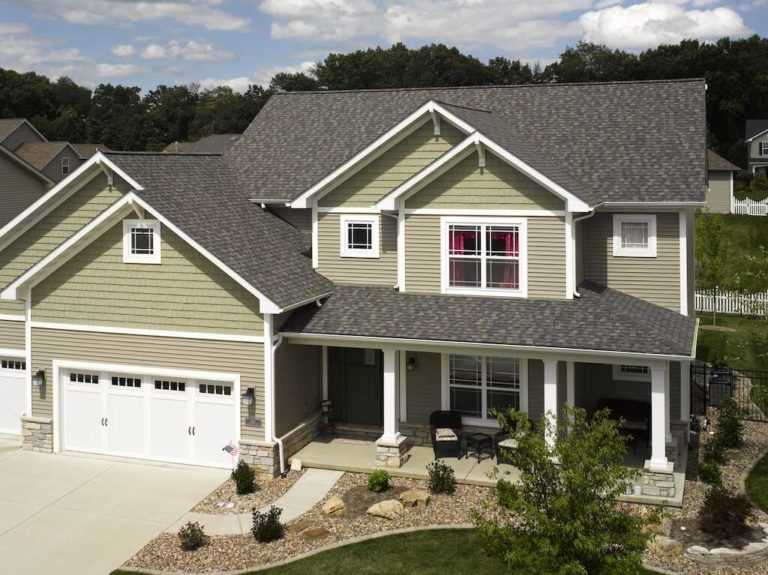Roofing Glossary A - Z

Asphalt Shingles: Roofing felt saturated with asphalt, coated on the weather side with a harder asphalt and aggregate particles, and cut into shingles for application to a sloped roof.
Bare Spots: Sections of a roof where the top layer is exposed to the elements.
Boot: A covering made of flexible material that can be preformed in a particular shape, used to exclude dust, moisture, dirt, etc. from around a penetration.
Bundle: A package of shingles (comes in 3, 4, or 5 bundles per square).
Caulking: A physical process of sealing a joint or juncture. Making the joints, seams or voids between surfaces weather-tight.
Chimney Flashing: Pieces of sheet metal or the like used to cover and protect certain joints and angles where a roof comes in contact with a chimney, especially against leakage.
Deck: A structural component of the roof of a building capable of supporting the weight of the roofing system.
Drip Edge: A metal flashing with an outward projecting lower edge intended to control the direction of dripping water and help protect underlying material.
EPDM: Ethylene propylene diene M-class rubber. Also know as a rubber roof. Used on low slope areas.
Fascia: A vertical or steeply sloped roof or trim located at the perimeter of a building. Typically, it is a border for the low-slope roof system that waterproofs the interior portions of the building.
Flashing: A thin, impervious sheet of material placed in construction to prevent water penetration or direct the flow of water. Flashing is used especially at roof hips and valleys, roof penetrations, joints between a roof and a vertical wall, and in masonry walls to direct the flow of water and moisture.
Gable: The vertical triangular portion of the end of a building having a double-sloping roof from the level of the eaves to the ridge of the roof.
Heat Welding: A method of melting and fusing together the overlapping edges of separate sheets/sections of polymer modified bitumen, thermoplastics or some uncured thermoset roofing membranes by the application of heat (in the form of hot air or open flame) and pressure.
Hip: The exterior inclining angle created by the junction of the sides of adjacent sloping roofs, excluding the ridge angle.
Ice Dam: A mass of ice formed at the transition from a warm to a cold roof surface, frequently formed by refreezing meltwater at the overhang of a steep roof causing ice and water to back up under roofing materials.
Joist: Any of the small timbers, metal or wood beams arranged parallel from wall to wall to support a floor, ceiling, or roof of a building.
Lap Seam: A lap seam occurs where overlapping materials are seamed, sealed, or otherwise bonded.
Membrane: A flexible or semi-flexible material, which functions as the waterproofing component in a roofing or waterproofing assembly, and whose primary function is the exclusion of water.
Open Valley: A method of valley construction in which the steep-slope roofing on both sides are trimmed along each side of the valley, exposing the valley flashing.
Pitch: A numerical measure of the steepness of a roof.
Polyvinyl Chloride (PVC): A synthetic thermoplastic polymer prepared from vinyl-chloride. An energy efficient roofing option due to their light coloring options. Used on flat or low sloped roofs.
Ridge: The horizontal line formed by the upper edges of two sloping roof surfaces.
Ridge Cap: A material or covering applied over the ridge of a roof.
Ridge Course: The last or top course of roofing materials, such as tile, roll roofing, shingles, that covers the ridge and overlaps the intersecting field roofing.
Ridge Vent: A ventilator located at the ridge that allows the escape of warm and/or moist air from the attic area or rafter cavity.
Roofing System: A system of interacting roof components generally consisting of a membrane or primary roof covering and roof insulation (not including the roof deck) designed to weatherproof and improve the building’s thermal resistance.
Shingle: Roof-covering unit made of asphalt, wood, slate, asbestos, cement, or other material cut into stock sizes and applied on sloping roofs in an overlapping pattern
Slope: is a numerical measure of the steepness of a roof. As known as “pitch”.
Soffit: The exposed undersurface of any exterior overhanging section of a roof eave.
Starter Course: The first layer of roofing, applied along a line adjacent to the downslope perimeter of the roof area; with steep-slope water-shedding roof coverings, the starter course is covered by the first course.
Starter Strip: Roll roofing or shingle strips applied along the downslope eave line before the first course of roof covering and intended to fill spaces between cutouts and joints of the first course.
Step Flashing: protects the interface between a roof and a wall from water leaks that can cause hidden damage.
Substrate: The surface which a roofing or waterproofing membrane is applied.
Underlayment: Asphalt saturated felt used beneath the roofing to provide additional protection for the deck.
Valley: The place where two planes of a roof meet at a downward, or V, angle.
Ready for Your Roof to Reach New Heights?

